Eric, I would have to agree with RON, at some point it is what it is..get it as close as possible and run it..if the belt temp and wear are good..clutching has to be pretty close under load........good info guys...
Install the app
How to install the app on iOS
Follow along with the video below to see how to install our site as a web app on your home screen.
Note: This feature may not be available in some browsers.
You are using an out of date browser. It may not display this or other websites correctly.
You should upgrade or use an alternative browser.
You should upgrade or use an alternative browser.
Calling IQ Guru's - Motor alignment issues
- Thread starter EricW
- Start date
Interesting thread, it has me wondering how many miles and how hard these sleds have been ridden that you guys are finding like this? Has anyone taken these measurements on a new IQ? I'm wondering with the results Erics' finding, how much would they change with some new factory motor mounts? I can't help but wonder how much wear in the motor mounts (boost especially) could be contributing to this.
Interesting thread, it has me wondering how many miles and how hard these sleds have been ridden that you guys are finding like this? Has anyone taken these measurements on a new IQ? I'm wondering with the results Erics' finding, how much would they change with some new factory motor mounts? I can't help but wonder how much wear in the motor mounts (boost especially) could be contributing to this.
On the bold, I checked the "mis-alignment " on my 2007 DRAGON 700 when it was brand new, 1 week old, after putting 500 miles on it.
.180" air gap @ the back of the secondary, had to slot the engine bracket nearly 3/8" to get it straight.
My bud's identical Dragon, checked it after 2500 miles (he's a gas, add oil, and maybe a slash of anti-freeze kinda guy) .140" air gap
BTW, my D7 used to glaze the belts, 1200 miles since I've re-aligned things, no glazing, noticeably quicker using my bud's D7 as a test mule sled, running s/s several 1 mile runs on hard pack.
I've got one more D7 to check soon, will post results.
Clutch mis-alignment
Eric W,
Another option for you would be to open the secondary and insert a 3/4" square aluminum/metal straight square stock approx 24" long.
Then that could be tried upper half and lower half of the secondary and measure with vernier calipers to the clutch edge.
Just a thought of another quick/simple way to verify dimensions.
Hope this helps
OK here is another intersting twist to my situaation. I borrowed the Polaris SPX "LWT" tool today from my deal and did some checking. The following numbers were achieved with the secondary pushed into the shaft, and the tool laying across the upper 1/3 of the secondary above the bolt (Upper) and with the tool laying across the lower 1/3 below the bolt (Lower). Two measurement were taken, at the front of the secondary and at the rear.
Polaris Tool - Upper Measurement
Front = .029"
Rear = .098" .069" difference
Polaris Tool - Lower Measurement
Front = .021"
Rear = .060" .039" difference
SLP Tool - Upper Measurement
Front = .230"
Rear = .374" .144" difference
SLP Lower Measurement
Front = 0 Just touched
Rear = 0 " " No difference
So what the hell does all this mean? It looks like my motor is not only rotated clockwise, but it is also lower on the PTO side, is this correct?
I dont know what to think.
This is what I mean by upper and lower
Upper
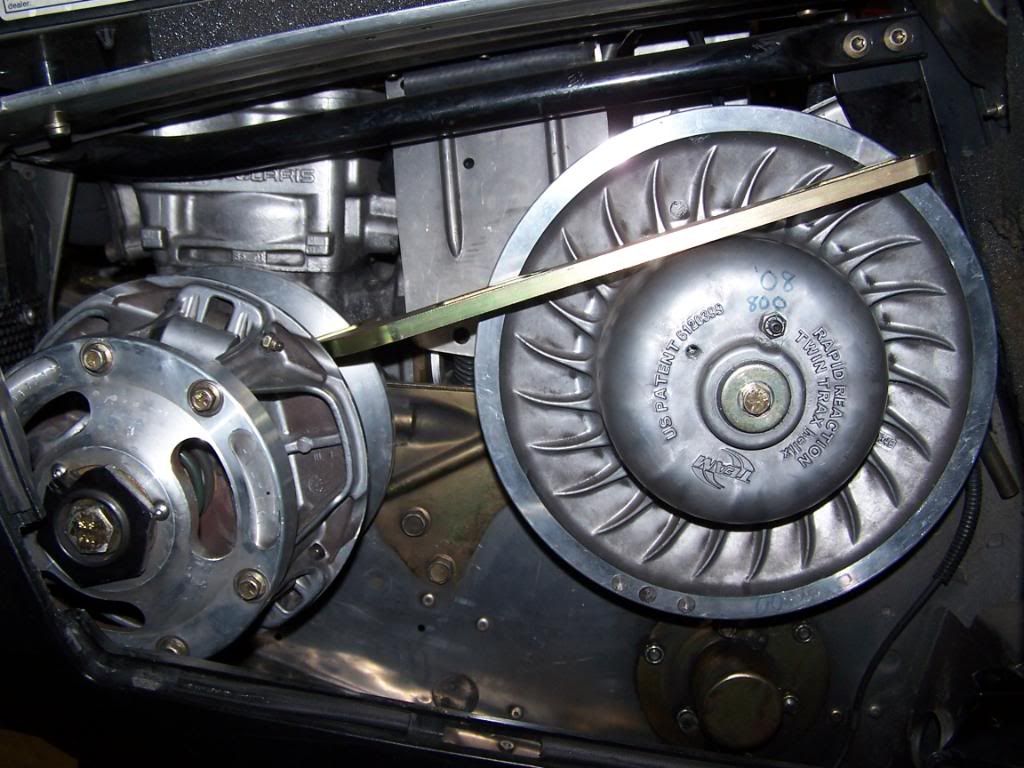
Lower
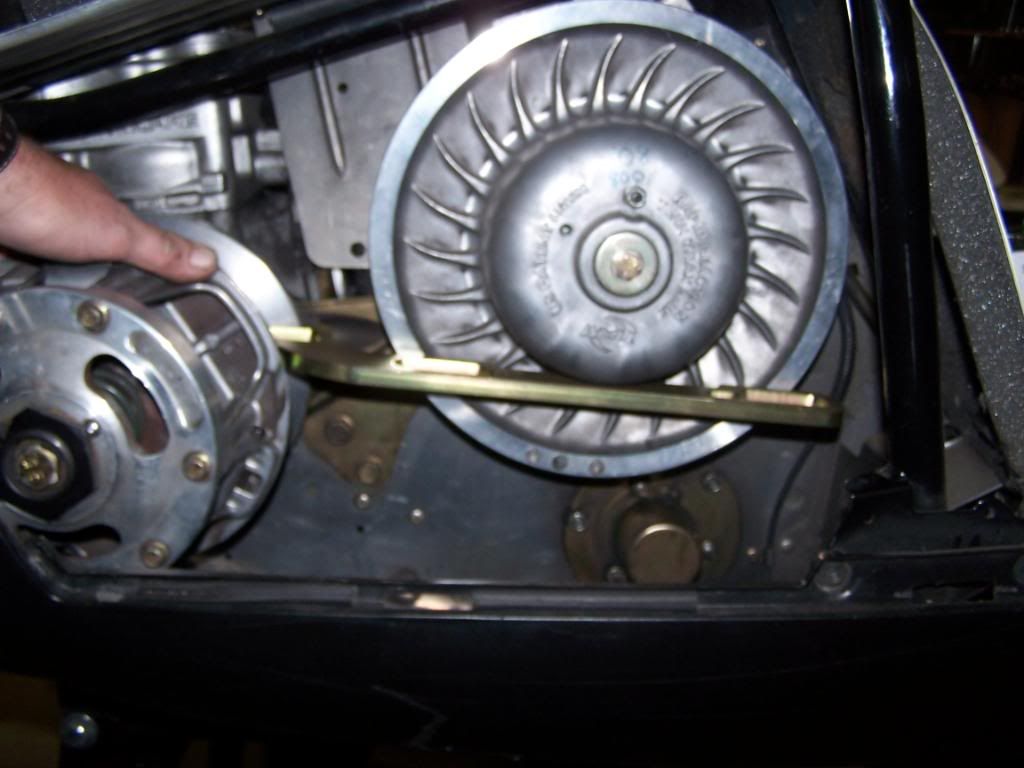
Thanks again for all the help. EW
Eric W,
Another option for you would be to open the secondary and insert a 3/4" square aluminum/metal straight square stock approx 24" long.
Then that could be tried upper half and lower half of the secondary and measure with vernier calipers to the clutch edge.
Just a thought of another quick/simple way to verify dimensions.
Hope this helps
Last edited:
E
EricW
Well-known member
Diamonddave, my sled was out by the stated amounts prior to running the turbo. I first checked it after I pulled the motor during the turbo build but it had not run yet. Sled had about 800 stock miles. These numbers / gaps have not really increased in 600+ bosted miles. I will be checking several new sleds next week just to see how it shakes out.
UPDATE:
I took a measurement using the SLP tool measuring from the bottom of the primary to the bottom of the secondary as Kraven stated above.
SLP Tool Lower Primary to Lower Secondary
Front - .216"
Rear - .354 .138" difference
Recap from above:
Polaris Tool - Upper Measurement
Front = .029"
Rear = .098" .069" difference
Polaris Tool - Lower Measurement
Front = .021"
Rear = .060" .039" difference
SLP Tool - Upper Measurement
Front = .230"
Rear = .374" .144" difference
SLP Tool Upper Primary to Lower Secondary Measurement
Front = 0 Just touched
Rear = 0 " " No difference
Using the SLP tool there was an increase in gap when going from top primary across lower secondary ( tool touched fron & rear) to lower primary across lower secondary (.216" front & .354" rear). Wouldn't these results cancel the idea that the primary is sitting below horizontal? I'm going back to the apron. lol. EW
UPDATE:
I took a measurement using the SLP tool measuring from the bottom of the primary to the bottom of the secondary as Kraven stated above.
SLP Tool Lower Primary to Lower Secondary
Front - .216"
Rear - .354 .138" difference
Recap from above:
Polaris Tool - Upper Measurement
Front = .029"
Rear = .098" .069" difference
Polaris Tool - Lower Measurement
Front = .021"
Rear = .060" .039" difference
SLP Tool - Upper Measurement
Front = .230"
Rear = .374" .144" difference
SLP Tool Upper Primary to Lower Secondary Measurement
Front = 0 Just touched
Rear = 0 " " No difference
Using the SLP tool there was an increase in gap when going from top primary across lower secondary ( tool touched fron & rear) to lower primary across lower secondary (.216" front & .354" rear). Wouldn't these results cancel the idea that the primary is sitting below horizontal? I'm going back to the apron. lol. EW
Last edited:
Motor alignment
I've been kind of following along in this thread. First, it isn't all that unusual to find motor alignments to be off somewhat in a new sled. What Kraven described with his sled is probably more of the "extreme case" than the norm, but it is impractical to "fine tune" every motor in every chassis as it leaves the factory, so there is going to be room for improvement. It's also important to think not only in simple "2-dimensional" terms with alignment. Its very possible for the motor to be higher or lower between the PTO and MAG side of the chassis. In the motor swaps that I've done, I've spent a bunch of time with alignment bars, torpedo levels on the motor and jackshaft, etc. trying to get the parts aligned the way I want. No matter how hard you try, you'll never get it perfect, but you will likely be able to make improvements. I also want to offer a differing opinion on how "closely" the motor and secondary clutch should be aligned. I'm going to suggest that going less than about 1/16" gap across the secondary is too close, unless you've got a low-HP motor. The motor puts a lot more pressure on the mounts than you can by hand - rubber torque stops will deform, motor mounts flex, motor straps flex and the jackshaft itself will "bow" under load. Even chassis flex contributes. In addition, setting up the center to center distance "dead-on" at 11.5" is also a mistake for the same reasons. Under load, the crankshaft gets closer to the jackshaft, so if you set up right on spec., center to center measurement gets further and further off the more load you put on the driveline. You want the clutches to work themselves closer to perfect alignment and center distance with increasing load, not move further away from it.
I've been kind of following along in this thread. First, it isn't all that unusual to find motor alignments to be off somewhat in a new sled. What Kraven described with his sled is probably more of the "extreme case" than the norm, but it is impractical to "fine tune" every motor in every chassis as it leaves the factory, so there is going to be room for improvement. It's also important to think not only in simple "2-dimensional" terms with alignment. Its very possible for the motor to be higher or lower between the PTO and MAG side of the chassis. In the motor swaps that I've done, I've spent a bunch of time with alignment bars, torpedo levels on the motor and jackshaft, etc. trying to get the parts aligned the way I want. No matter how hard you try, you'll never get it perfect, but you will likely be able to make improvements. I also want to offer a differing opinion on how "closely" the motor and secondary clutch should be aligned. I'm going to suggest that going less than about 1/16" gap across the secondary is too close, unless you've got a low-HP motor. The motor puts a lot more pressure on the mounts than you can by hand - rubber torque stops will deform, motor mounts flex, motor straps flex and the jackshaft itself will "bow" under load. Even chassis flex contributes. In addition, setting up the center to center distance "dead-on" at 11.5" is also a mistake for the same reasons. Under load, the crankshaft gets closer to the jackshaft, so if you set up right on spec., center to center measurement gets further and further off the more load you put on the driveline. You want the clutches to work themselves closer to perfect alignment and center distance with increasing load, not move further away from it.
In addition, setting up the center to center distance "dead-on" at 11.5" is also a mistake for the same reasons. Under load, the crankshaft gets closer to the jackshaft, so if you set up right on spec., center to center measurement gets further and further off the more load you put on the driveline. You want the clutches to work themselves closer to perfect alignment and center distance with increasing load, not move further away from it.
And then you would have to find out if the factory specification has already take all these variations into account? I mean, is the factory center-to-center distance given "in rest" and it is supposed to be shorter during load. I think it would be very impractical to give the measurements under load as how are you supposed to easily check/adjust the motor mounts while motor is under load and not lose a finger?
And then you would have to find out if the factory specification has already take all these variations into account? I mean, is the factory center-to-center distance given "in rest" and it is supposed to be shorter during load. I think it would be very impractical to give the measurements under load as how are you supposed to easily check/adjust the motor mounts while motor is under load and not lose a finger?
well said
Clutch alignment
Obviously, you can't make the measurement with the motor under load (and don't ever attempt it!!), but that doesn't mean that the factory spec takes into account any of the things I mentioned previously. The factory spec is a "guideline" based on some theoretical "ideal situation". The factory doesn't sit down and figure out how much parts flex, how much belt lengths vary, how much the motor twists, etc. The spec is the same whether it's a fan cooled 440 or an 800 triple/triple. Common sense would say that those motors will move different amounts under load, flex other components differently under load, etc, right? If the spec took this into account, the spec should be unique for each motor in the lineup. Here is another one: If you've handled enough drive belts, you know how much they can vary in length. If the length doesn't match the "ideal", that center to center distance given in the factory spec is wrong for the belt - yet the factory spec doesn't make any allowance for that. Instead, they "fudge" it with an adjustable secondary clutch. A race team will sort their belts and find the ones that match most closely with their setup. That is the difference between "on paper", which is what the factory does and what is "real life", which is what a race team or a dedicated owner might look into. There are a lot of things in the sled that the factory does "on paper" and end up only being "close enough" to make your sled run and go down the trail.
And then you would have to find out if the factory specification has already take all these variations into account? I mean, is the factory center-to-center distance given "in rest" and it is supposed to be shorter during load. I think it would be very impractical to give the measurements under load as how are you supposed to easily check/adjust the motor mounts while motor is under load and not lose a finger?
Obviously, you can't make the measurement with the motor under load (and don't ever attempt it!!), but that doesn't mean that the factory spec takes into account any of the things I mentioned previously. The factory spec is a "guideline" based on some theoretical "ideal situation". The factory doesn't sit down and figure out how much parts flex, how much belt lengths vary, how much the motor twists, etc. The spec is the same whether it's a fan cooled 440 or an 800 triple/triple. Common sense would say that those motors will move different amounts under load, flex other components differently under load, etc, right? If the spec took this into account, the spec should be unique for each motor in the lineup. Here is another one: If you've handled enough drive belts, you know how much they can vary in length. If the length doesn't match the "ideal", that center to center distance given in the factory spec is wrong for the belt - yet the factory spec doesn't make any allowance for that. Instead, they "fudge" it with an adjustable secondary clutch. A race team will sort their belts and find the ones that match most closely with their setup. That is the difference between "on paper", which is what the factory does and what is "real life", which is what a race team or a dedicated owner might look into. There are a lot of things in the sled that the factory does "on paper" and end up only being "close enough" to make your sled run and go down the trail.
Clutch mis-alignment continued
There used to be a bigger variation in belt lengths years ago, in fact if you look at the old Erlandson Performance Catalogs they would have approx 4 or 5 different lenghts for the old style 3211042/3211045 belt.
With the "EDGE belt #3211080 is standard, then POLARIS offers a 3211087 CLOSE TOLERANCE BELT.
With the new Kevlar 3211115, there is no close tolerance version offered and I was told by SLP that it is not necceasry, that the manufacturing tolerances are very close today much more so that in prior years.
Speaking of SLP, they recommend the following AIR GAP at the back of the secondary when checking offsets;
1) ZERO to .020" When using their push limiter on the mag side
2) .020" to .040" with out their push limiter.
I spoke with Dustin (Boondockers Turbo 700 Dragon ) and another employee there approx 1 year ago just before I slotted my engine brackets, and here's what SLP said:
"We've seen this mis-alignment on ALL BRANDS of sleds, we run into it from time to time, it is CRITICAL for performance to correct this, and furthermore the .070" POLARIS spec is too much, that's why we recommend .020"
SLP tech line (208) 529-0244
I've had several 2001-2003 EDGE sleds, between me and my buds, alignment has been pretty close, I fine tuned it by placing thin Chevrolet starter shims behind the rear engine bracket (mag side) to straighten things out.
In 1996 I bought a brand new 96 STORM 800, the c/c was 1/4" LONG, the sled would barely idle, sled kept creeping forward even with the secondary fully opened up, top speed 95 m.p.h. on the dream-o-meter, I was NOT happy.
My dealer, Brucker's POLARIS in Gibson City , Illinois refused to believe it as well, until I brought it back to them after my first trip with 500 miles on it. We removed the engine right there in their shop, slotted the engine to bracket holes and it was fine.
Actually more than fine, I ran it in January 1996 on LAKE COMO, Mar's Resort Annual Radar run in 1000' ran 105.3 M.P.H. on the radar gun, took 2nd place in the 800 STOCK class, and by comparison, the fastest 900 STOCK THUNDERCAT was 105.1 m.p.h. (with 10+ t-cats competing in that class)
Way back in 1984 when I was 22, I built a '72 Dodge Colt, Full Tube Chassis car in my garage, another in a series of 1/4 mile drag cars, Strange Struts, 4-link rear, Koni Coil Overs externally adjustable, 15" x 33"s, Did all my own Fabricating, including Aluminum Motor Plates, Mid-Plates to Accomodate a 426 Wegde Motor, Trans mounts, set-up the Narrowed Dana 60, built the Torqueflite Trans, Engine, etc, Lexan Widows, Quick Release Dzus Fasteners and Quick Release Pins Everywhere, 2220 lbs, with driver.
Leaving the starting line plastered to the back on my seat carrying the front wheels in the air and stopping it from 133+ m.p.h. by pulling the parachute, PRICELESS!!!
I know what it takes to be fast, and know what it takes to make and build things right.
And I might have even learned a few things since then, lol


'Nuff said.
Obviously, you can't make the measurement with the motor under load (and don't ever attempt it!!), but that doesn't mean that the factory spec takes into account any of the things I mentioned previously. The factory spec is a "guideline" based on some theoretical "ideal situation". The factory doesn't sit down and figure out how much parts flex, how much belt lengths vary, how much the motor twists, etc. The spec is the same whether it's a fan cooled 440 or an 800 triple/triple. Common sense would say that those motors will move different amounts under load, flex other components differently under load, etc, right? If the spec took this into account, the spec should be unique for each motor in the lineup. Here is another one: If you've handled enough drive belts, you know how much they can vary in length. If the length doesn't match the "ideal", that center to center distance given in the factory spec is wrong for the belt - yet the factory spec doesn't make any allowance for that. Instead, they "fudge" it with an adjustable secondary clutch. A race team will sort their belts and find the ones that match most closely with their setup. That is the difference between "on paper", which is what the factory does and what is "real life", which is what a race team or a dedicated owner might look into. There are a lot of things in the sled that the factory does "on paper" and end up only being "close enough" to make your sled run and go down the trail.
There used to be a bigger variation in belt lengths years ago, in fact if you look at the old Erlandson Performance Catalogs they would have approx 4 or 5 different lenghts for the old style 3211042/3211045 belt.
With the "EDGE belt #3211080 is standard, then POLARIS offers a 3211087 CLOSE TOLERANCE BELT.
With the new Kevlar 3211115, there is no close tolerance version offered and I was told by SLP that it is not necceasry, that the manufacturing tolerances are very close today much more so that in prior years.
Speaking of SLP, they recommend the following AIR GAP at the back of the secondary when checking offsets;
1) ZERO to .020" When using their push limiter on the mag side
2) .020" to .040" with out their push limiter.
I spoke with Dustin (Boondockers Turbo 700 Dragon ) and another employee there approx 1 year ago just before I slotted my engine brackets, and here's what SLP said:
"We've seen this mis-alignment on ALL BRANDS of sleds, we run into it from time to time, it is CRITICAL for performance to correct this, and furthermore the .070" POLARIS spec is too much, that's why we recommend .020"
SLP tech line (208) 529-0244
I've had several 2001-2003 EDGE sleds, between me and my buds, alignment has been pretty close, I fine tuned it by placing thin Chevrolet starter shims behind the rear engine bracket (mag side) to straighten things out.
In 1996 I bought a brand new 96 STORM 800, the c/c was 1/4" LONG, the sled would barely idle, sled kept creeping forward even with the secondary fully opened up, top speed 95 m.p.h. on the dream-o-meter, I was NOT happy.
My dealer, Brucker's POLARIS in Gibson City , Illinois refused to believe it as well, until I brought it back to them after my first trip with 500 miles on it. We removed the engine right there in their shop, slotted the engine to bracket holes and it was fine.
Actually more than fine, I ran it in January 1996 on LAKE COMO, Mar's Resort Annual Radar run in 1000' ran 105.3 M.P.H. on the radar gun, took 2nd place in the 800 STOCK class, and by comparison, the fastest 900 STOCK THUNDERCAT was 105.1 m.p.h. (with 10+ t-cats competing in that class)
Way back in 1984 when I was 22, I built a '72 Dodge Colt, Full Tube Chassis car in my garage, another in a series of 1/4 mile drag cars, Strange Struts, 4-link rear, Koni Coil Overs externally adjustable, 15" x 33"s, Did all my own Fabricating, including Aluminum Motor Plates, Mid-Plates to Accomodate a 426 Wegde Motor, Trans mounts, set-up the Narrowed Dana 60, built the Torqueflite Trans, Engine, etc, Lexan Widows, Quick Release Dzus Fasteners and Quick Release Pins Everywhere, 2220 lbs, with driver.
Leaving the starting line plastered to the back on my seat carrying the front wheels in the air and stopping it from 133+ m.p.h. by pulling the parachute, PRICELESS!!!
I know what it takes to be fast, and know what it takes to make and build things right.
And I might have even learned a few things since then, lol


'Nuff said.
Last edited:
On the bold, I checked the "mis-alignment " on my 2007 DRAGON 700 when it was brand new, 1 week old, after putting 500 miles on it.
.180" air gap @ the back of the secondary, had to slot the engine bracket nearly 3/8" to get it straight.
I've got one more D7 to check soon, will post results.
Diamonddave, my sled was out by the stated amounts prior to running the turbo. I first checked it after I pulled the motor during the turbo build but it had not run yet. Sled had about 800 stock miles. These numbers / gaps have not really increased in 600+ bosted miles. I will be checking several new sleds next week just to see how it shakes out.
Cool, I hope my question didn't ruffle feathers, just had me pondering the what if's as we've seen weak mounts before. Eric, for some reason I had thought all your sleds' miles were on boost. The only other thing that I'm wondering is are we dealing with a perfect in-line jackshaft? I know it doesn't matter which is actually out of alignment, but it would be kinda nice to know why you guys have gotten such extreme alignment issues.
I will order an SLP tool tomorrow. I've got a new zero mile 09, an 860 R&R, and a 685 to rebuild so in my best Chris Farley voice, "I'll check it out"
Cool info guys.
Common sense would say that those motors will move different amounts under load, flex other components differently under load, etc, right?
Yes, you are right. Shame, shame on you Polaris
E
EricW
Well-known member
Cool, I hope my question didn't ruffle feathers, just had me pondering the what if's as we've seen weak mounts before. Eric, for some reason I had thought all your sleds' miles were on boost. The only other thing that I'm wondering is are we dealing with a perfect in-line jackshaft? I know it doesn't matter which is actually out of alignment, but it would be kinda nice to know why you guys have gotten such extreme alignment issues.
I will order an SLP tool tomorrow. I've got a new zero mile 09, an 860 R&R, and a 685 to rebuild so in my best Chris Farley voice, "I'll check it out"
Cool info guys.
No ruffled feathers here Dave, i apreciate all info on this. I too am wondering about the jack shaft as well as many other possibilities. I will be looking into that as well. I have also had boost leak issues at the throttle bodies that seem to be far beyond what anyone else has experienced. Either I have an unusual situation or most don't have the stuff to do a "true" leak test and don't know they are leaking too. At one point Boondockers worked over my intercooler/throttle bodies and they were leak tight on the bench. When I got them back and installed them the leaks were better but still there. I am really wondering if this is somehow related to the alignment issue since it too is a symptom that is a head scratcher right now.
I have not looked at that sled or even walked in the shop for 2 days now. Once I have forgotten all I think I know about this issue I will try it again with a clear head. The answers are there, I'm just not seeing it. I'll keep posting as I screw up more stuff for those who are getting a chuckle out of this, and no, those aren't my lip prints on the window of the little bus. They were already there. Have a good one. EW
E
EricW
Well-known member
Well here's my latest update. Seems that the Polaris SPX (LWT) tool is really finicky about how it seats in the primary fixed sheave and the the resulting clearances if not seated properly. What we found is that with the machined contact points on the tips of this tool you actually have to rotate the primary (clockwise worked best for me) a 1/4 turn or so to get it to seat properly. If you just put the tool in and wiggle it until it seems seated you will get the bigger gaps at the secondary that I posted above. If you hold some down and in pressure with one hand while you spin the primary gently you will feel it fall into its proper machined fit. I did this with 3 IQ's and all results were the same using the tool I borrowed from my dealer All three sled were within .010 of each other and well within the Polaris spec in the shop manual (Though this is still an issue with the .075" tool "Kick" as Kraven stated). I will keep working on this, but for now its time to run the sled, watch the belt, and see what happens.
Seating the tool and spinning the primary clockwise
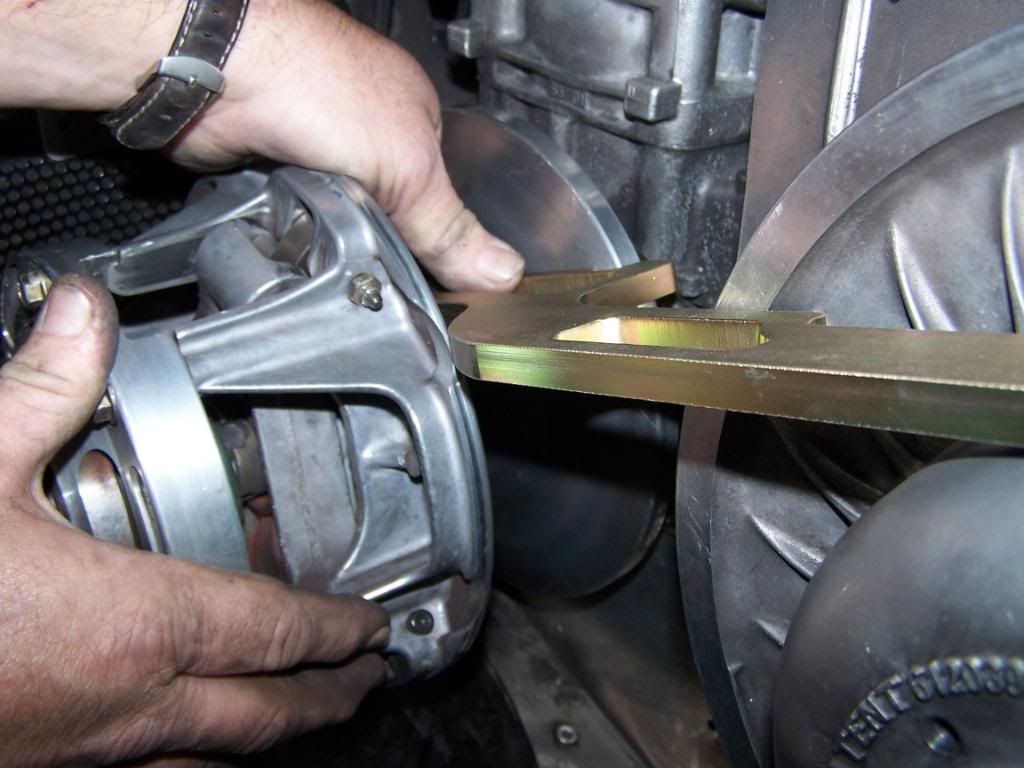
With the tool properly seated I got just touching in the front of the secondary and a loose .006" at the rear measuring above the bolts on both clutches
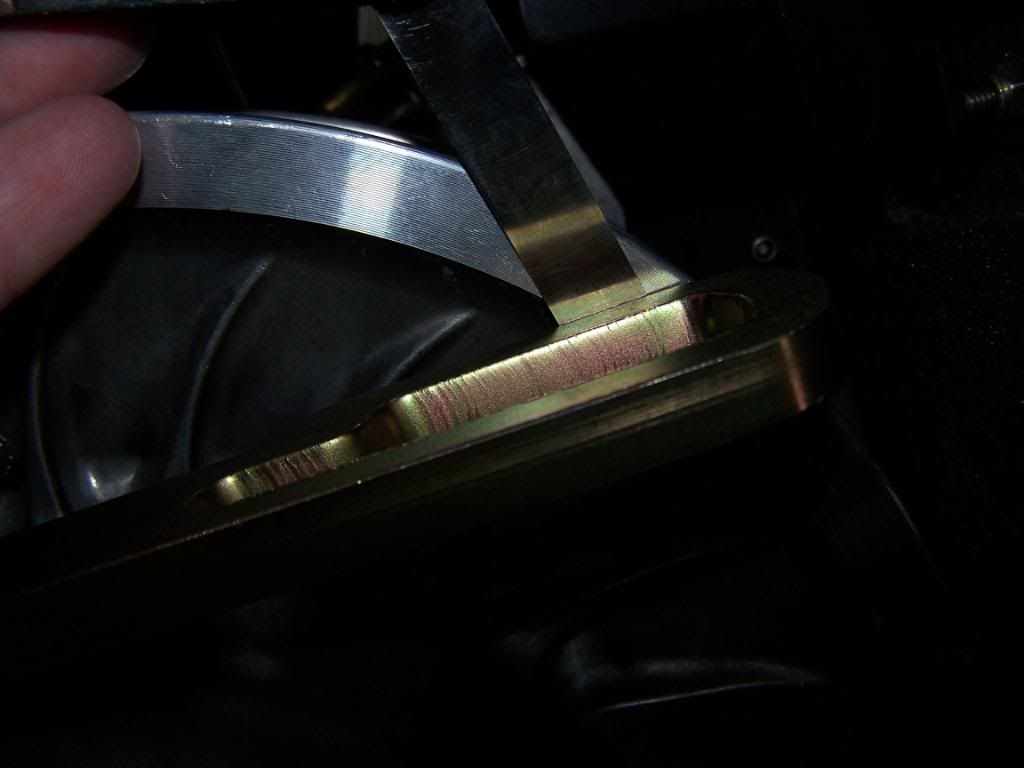
If you dont have an air gap at the heel of the tool between it and the movable sheave you will get a bad reading. Should look like this
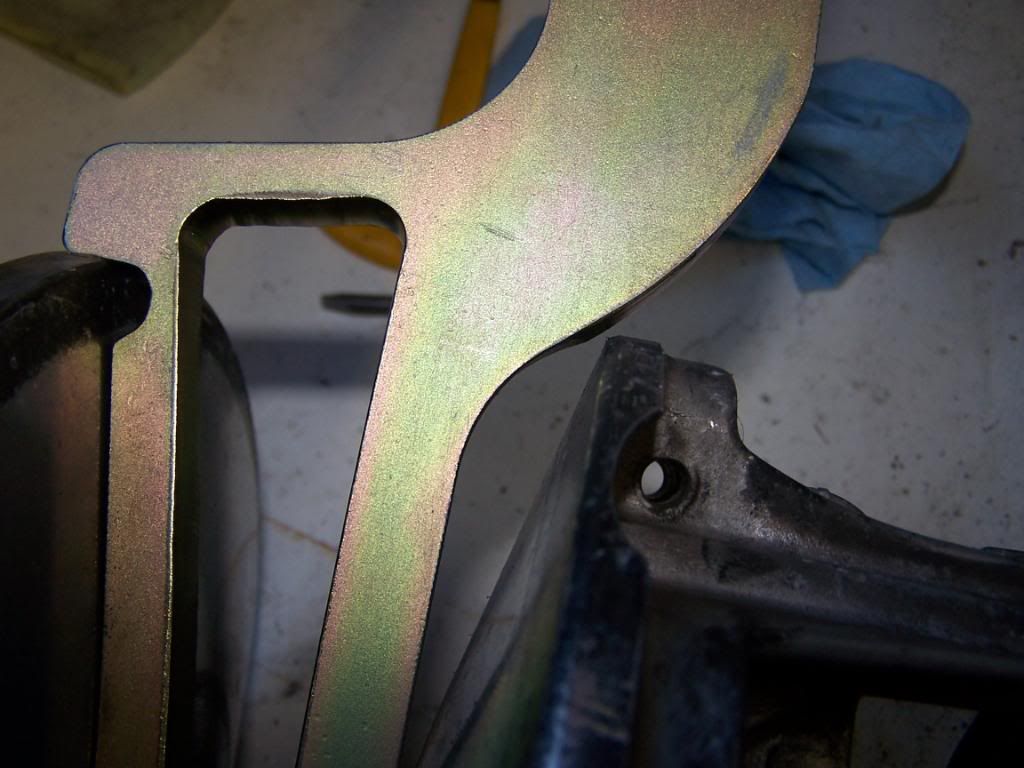
As much as possible try to make sure that the radial gap around the fixed sheave between it and the tool looks uniform like this
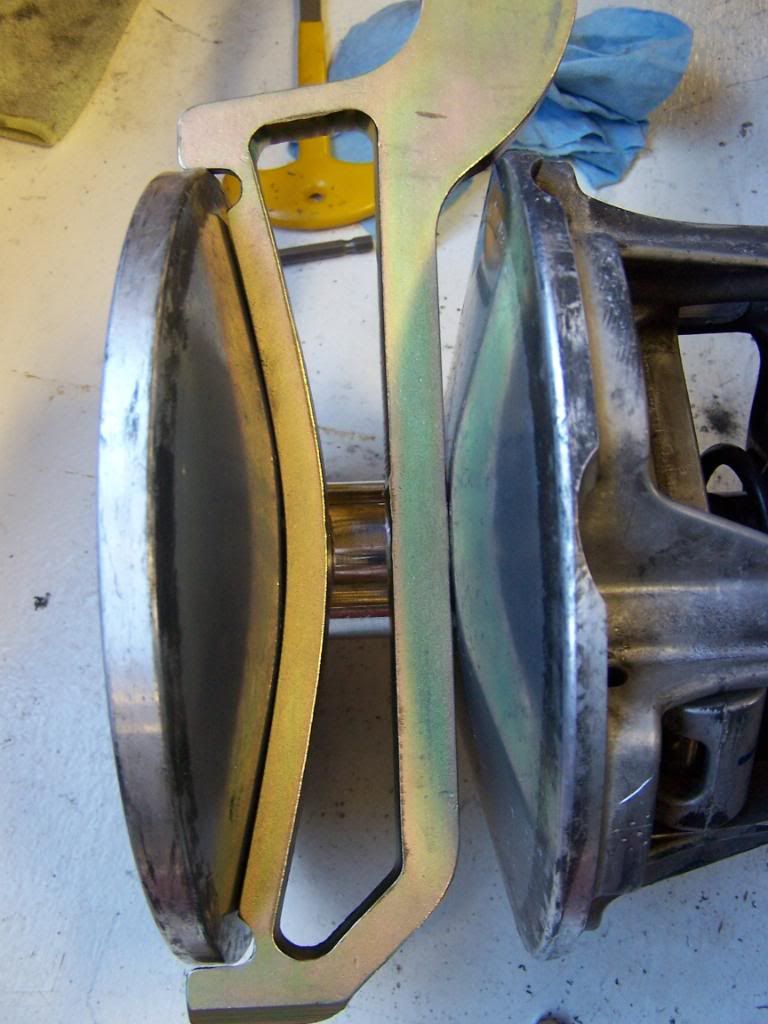
Still going to look at the jack shaft and maybe even try to McGiver a way to put an indicator somewhere on the motor that would leave a mark of how much torque travel and in what directions movement is happening under load.
Would one of those water operated Dyno's allow a guy to see accurate torque movement on the stand?
The saga continues. EW
Seating the tool and spinning the primary clockwise

With the tool properly seated I got just touching in the front of the secondary and a loose .006" at the rear measuring above the bolts on both clutches

If you dont have an air gap at the heel of the tool between it and the movable sheave you will get a bad reading. Should look like this

As much as possible try to make sure that the radial gap around the fixed sheave between it and the tool looks uniform like this

Still going to look at the jack shaft and maybe even try to McGiver a way to put an indicator somewhere on the motor that would leave a mark of how much torque travel and in what directions movement is happening under load.
Would one of those water operated Dyno's allow a guy to see accurate torque movement on the stand?
The saga continues. EW
Last edited:
Good Thread

